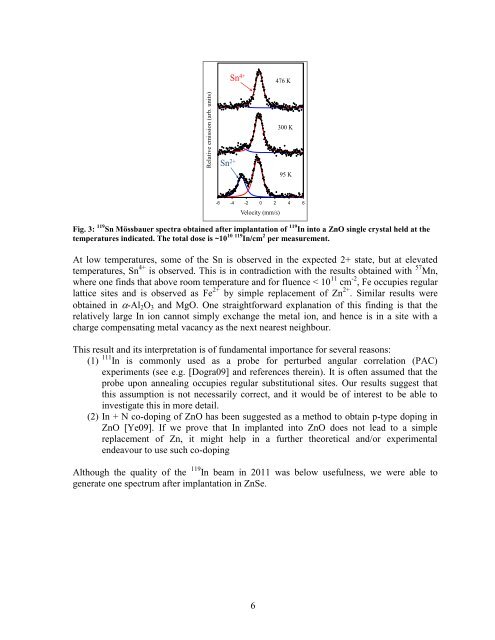INTC-2012-005/INTC-P-275-ADD-1 - CERN Document Server
INTC-2012-005/INTC-P-275-ADD-1 - CERN Document Server
INTC-2012-005/INTC-P-275-ADD-1 - CERN Document Server
Create successful ePaper yourself
Turn your PDF publications into a flip-book with our unique Google optimized e-Paper software.
Relative emission (arb. units)<br />
Sn 2+<br />
Sn 4+<br />
-6 -4 -2 0 2 4 6<br />
Velocity (mm/s)<br />
Fig. 3: 119 Sn Mössbauer spectra obtained after implantation of 119 In into a ZnO single crystal held at the<br />
temperatures indicated. The total dose is ~10 10 119 In/cm 2 per measurement.<br />
At low temperatures, some of the Sn is observed in the expected 2+ state, but at elevated<br />
temperatures, Sn 4+ is observed. This is in contradiction with the results obtained with 57 Mn,<br />
where one finds that above room temperature and for fluence < 10 11 cm -2 , Fe occupies regular<br />
lattice sites and is observed as Fe 2+ by simple replacement of Zn 2+ . Similar results were<br />
obtained in -Al2O3 and MgO. One straightforward explanation of this finding is that the<br />
relatively large In ion cannot simply exchange the metal ion, and hence is in a site with a<br />
charge compensating metal vacancy as the next nearest neighbour.<br />
This result and its interpretation is of fundamental importance for several reasons:<br />
(1) 111 In is commonly used as a probe for perturbed angular correlation (PAC)<br />
experiments (see e.g. [Dogra09] and references therein). It is often assumed that the<br />
probe upon annealing occupies regular substitutional sites. Our results suggest that<br />
this assumption is not necessarily correct, and it would be of interest to be able to<br />
investigate this in more detail.<br />
(2) In + N co-doping of ZnO has been suggested as a method to obtain p-type doping in<br />
ZnO [Ye09]. If we prove that In implanted into ZnO does not lead to a simple<br />
replacement of Zn, it might help in a further theoretical and/or experimental<br />
endeavour to use such co-doping<br />
Although the quality of the 119 In beam in 2011 was below usefulness, we were able to<br />
generate one spectrum after implantation in ZnSe.<br />
6<br />
476 K<br />
300 K<br />
95 K















